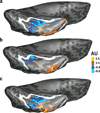Connectivity precedes function in the development of the visual word form area
- PMID: 27500407
- PMCID: PMC5003691
- DOI: 10.1038/nn.4354
Connectivity precedes function in the development of the visual word form area
Abstract
What determines the cortical location at which a given functionally specific region will arise in development? We tested the hypothesis that functionally specific regions develop in their characteristic locations because of pre-existing differences in the extrinsic connectivity of that region to the rest of the brain. We exploited the visual word form area (VWFA) as a test case, scanning children with diffusion and functional imaging at age 5, before they learned to read, and at age 8, after they learned to read. We found the VWFA developed functionally in this interval and that its location in a particular child at age 8 could be predicted from that child's connectivity fingerprints (but not functional responses) at age 5. These results suggest that early connectivity instructs the functional development of the VWFA, possibly reflecting a general mechanism of cortical development.
Figures





Comment in
-
Cerebral cortex: Connecting with words.Nat Rev Neurosci. 2016 Oct;17(10):604-5. doi: 10.1038/nrn.2016.123. Epub 2016 Aug 25. Nat Rev Neurosci. 2016. PMID: 27558537 No abstract available.
-
Is the brain prewired for letters?Nat Neurosci. 2016 Aug 26;19(9):1192-3. doi: 10.1038/nn.4369. Nat Neurosci. 2016. PMID: 27571199 No abstract available.
References
-
- Hannagan T, Amedi A, Cohen L, Dehaene-Lambertz G, Dehaene S. Origins of the specialization for letters and numbers in ventral occipitotemporal cortex. Trends Cogn. Sci. 2015;19:374–382. - PubMed
-
- Sur M, Garraghty PE, Roe AW. Experimentally induced visual projections into auditory thalamus and cortex. Science. 1988;242:1437–1441. - PubMed
Publication types
MeSH terms
Grants and funding
LinkOut - more resources
Full Text Sources
Other Literature Sources

